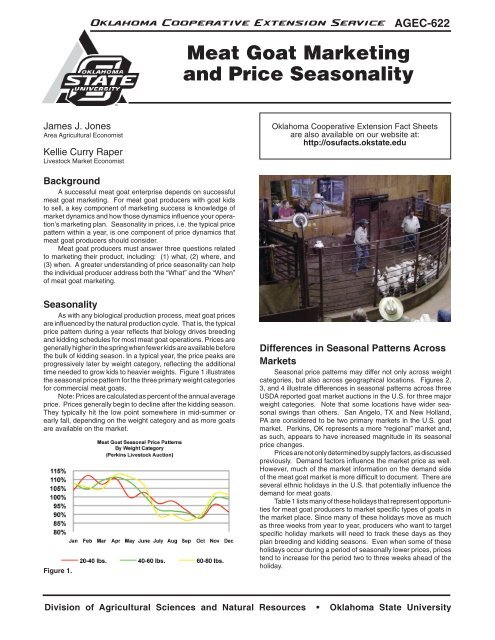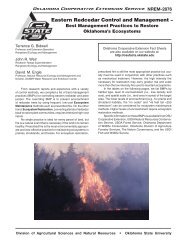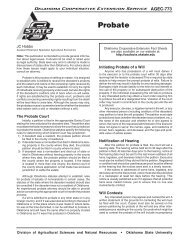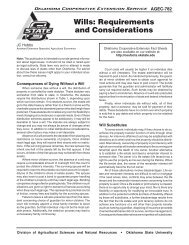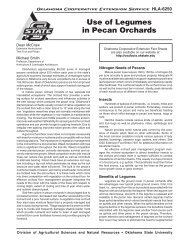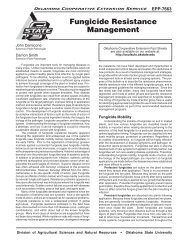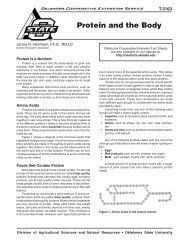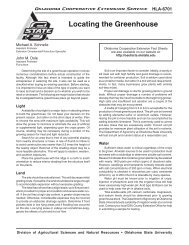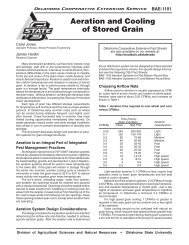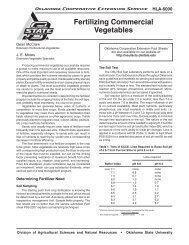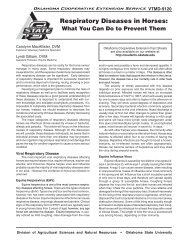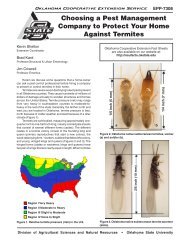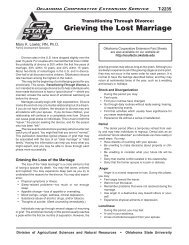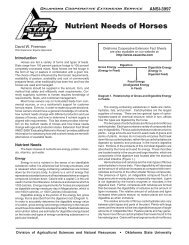Meat Goat Marketing and Price Seasonality - OSU Fact Sheets ...
Meat Goat Marketing and Price Seasonality - OSU Fact Sheets ...
Meat Goat Marketing and Price Seasonality - OSU Fact Sheets ...
Create successful ePaper yourself
Turn your PDF publications into a flip-book with our unique Google optimized e-Paper software.
Oklahoma Cooperative Extension Service<br />
AGEC-622<br />
<strong>Meat</strong> <strong>Goat</strong> <strong>Marketing</strong><br />
<strong>and</strong> <strong>Price</strong> <strong>Seasonality</strong><br />
James J. Jones<br />
Area Agricultural Economist<br />
Kellie Curry Raper<br />
Livestock Market Economist<br />
Oklahoma Cooperative Extension <strong>Fact</strong> <strong>Sheets</strong><br />
are also available on our website at:<br />
http://osufacts.okstate.edu<br />
Background<br />
A successful meat goat enterprise depends on successful<br />
meat goat marketing. For meat goat producers with goat kids<br />
to sell, a key component of marketing success is knowledge of<br />
market dynamics <strong>and</strong> how those dynamics influence your operation’s<br />
marketing plan. <strong>Seasonality</strong> in prices, i.e. the typical price<br />
pattern within a year, is one component of price dynamics that<br />
meat goat producers should consider.<br />
<strong>Meat</strong> goat producers must answer three questions related<br />
to marketing their product, including: (1) what, (2) where, <strong>and</strong><br />
(3) when. A greater underst<strong>and</strong>ing of price seasonality can help<br />
the individual producer address both the “What” <strong>and</strong> the “When”<br />
of meat goat marketing.<br />
<strong>Seasonality</strong><br />
As with any biological production process, meat goat prices<br />
are influenced by the natural production cycle. That is, the typical<br />
price pattern during a year reflects that biology drives breeding<br />
<strong>and</strong> kidding schedules for most meat goat operations. <strong>Price</strong>s are<br />
generally higher in the spring when fewer kids are available before<br />
the bulk of kidding season. In a typical year, the price peaks are<br />
progressively later by weight category, reflecting the additional<br />
time needed to grow kids to heavier weights. Figure 1 illustrates<br />
the seasonal price pattern for the three primary weight categories<br />
for commercial meat goats.<br />
Note: <strong>Price</strong>s are calculated as percent of the annual average<br />
price. <strong>Price</strong>s generally begin to decline after the kidding season.<br />
They typically hit the low point somewhere in mid-summer or<br />
early fall, depending on the weight category <strong>and</strong> as more goats<br />
are available on the market.<br />
Figure 1.<br />
Differences in Seasonal Patterns Across<br />
Markets<br />
Seasonal price patterns may differ not only across weight<br />
categories, but also across geographical locations. Figures 2,<br />
3, <strong>and</strong> 4 illustrate differences in seasonal patterns across three<br />
USDA reported goat market auctions in the U.S. for three major<br />
weight categories. Note that some locations have wider seasonal<br />
swings than others. San Angelo, TX <strong>and</strong> New Holl<strong>and</strong>,<br />
PA are considered to be two primary markets in the U.S. goat<br />
market. Perkins, OK represents a more “regional” market <strong>and</strong>,<br />
as such, appears to have increased magnitude in its seasonal<br />
price changes.<br />
<strong>Price</strong>s are not only determined by supply factors, as discussed<br />
previously. Dem<strong>and</strong> factors influence the market price as well.<br />
However, much of the market information on the dem<strong>and</strong> side<br />
of the meat goat market is more difficult to document. There are<br />
several ethnic holidays in the U.S. that potentially influence the<br />
dem<strong>and</strong> for meat goats.<br />
Table 1 lists many of these holidays that represent opportunities<br />
for meat goat producers to market specific types of goats in<br />
the market place. Since many of these holidays move as much<br />
as three weeks from year to year, producers who want to target<br />
specific holiday markets will need to track these days as they<br />
plan breeding <strong>and</strong> kidding seasons. Even when some of these<br />
holidays occur during a period of seasonally lower prices, prices<br />
tend to increase for the period two to three weeks ahead of the<br />
holiday.<br />
Division of Agricultural Sciences <strong>and</strong> Natural Resources • Oklahoma State University
Seasonal Patterns <strong>and</strong> Selected Ethnic holidays:<br />
20 lb. to 40 lb. <strong>Goat</strong>s<br />
Seasonal Patterns <strong>and</strong> Selected Ethnic holidays:<br />
60 lb. to 80 lb. <strong>Goat</strong>s<br />
Figure 2.<br />
Seasonal Patterns <strong>and</strong> Selected Ethnic holidays:<br />
40 lb. to 60 lb. <strong>Goat</strong>s<br />
Figure 4.<br />
While an individual year’s price pattern may vary from the<br />
typical seasonal pattern, the seasonal price index provides insight<br />
into long term “normal” price patterns. Knowledge of seasonal<br />
price patterns can be utilized to enhance producer marketing<br />
strategies, sometimes by adjusting production patterns. For some<br />
producers, it may be feasible to shift the timing of production in<br />
order to market kids of specific weights during periods where<br />
prices are seasonally higher. Other producers may choose to focus<br />
on having sufficient quantity to market animals during periods of<br />
high dem<strong>and</strong>, regardless of the seasonal price level. While an<br />
individual producer cannot impact or control price, the timing of<br />
marketing decisions can make an impact on your bottom line.<br />
Figure 3.<br />
Table 1. Various Holidays <strong>and</strong> Celebrations Where <strong>Goat</strong> is Typically Served.<br />
Holiday Date Size of Kid Comments<br />
Easter (Western) Late March/Early April 20 to 50 pounds Date varies<br />
Easter (Eastern <strong>and</strong> Greek) Mid to Late April 20 to 50 pounds Date varies<br />
Cinco de Mayo (Hispanic) May 5 20 to 35 pounds<br />
Independence Day July 4 20 to 35 pounds Older kids accepted<br />
Caribbean Holidays August 60 pounds Bucks only<br />
Start of Ramadan (Muslim) Late August/mid-September 45 to 120 pounds Less than 12 months old; Date varies<br />
Eid al Fitr (Muslim) Late September/mid-October 45 to 120 pounds 60 pounds optimum<br />
Eid al Adha (Muslim) Late November/Early December Yearlings, blemish free; Date varies<br />
Dassai (Hindu) Late September/Mid-October Male goats only; Date varies; Size varies<br />
This material is based upon work supported by USDA/CSREES under Award Number 2008<br />
RME-DF102624.<br />
Oklahoma State University, in compliance with Title VI <strong>and</strong> VII of the Civil Rights Act of 1964, Executive Order 11246 as amended, Title IX of the Education Amendments of 1972, Americans<br />
with Disabilities Act of 1990, <strong>and</strong> other federal laws <strong>and</strong> regulations, does not discriminate on the basis of race, color, national origin, gender, age, religion, disability, or status as a veteran in<br />
any of its policies, practices, or procedures. This includes but is not limited to admissions, employment, financial aid, <strong>and</strong> educational services.<br />
Issued in furtherance of Cooperative Extension work, acts of May 8 <strong>and</strong> June 30, 1914, in cooperation with the U.S. Department of Agriculture, Robert E. Whitson, Director of Cooperative Extension<br />
Service, Oklahoma State University, Stillwater, Oklahoma. This publication is printed <strong>and</strong> issued by Oklahoma State University as authorized by the Vice President, Dean, <strong>and</strong> Director of<br />
the Division of Agricultural Sciences <strong>and</strong> Natural Resources <strong>and</strong> has been prepared <strong>and</strong> distributed at a cost of 20 cents per copy. 0309<br />
AGEC-622-2


